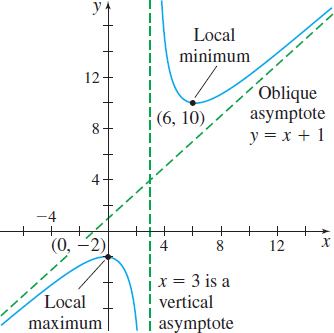EXAMPLE 3Using Calculus to Graph a Rational Function
Graph f(x)=x2−2x+6x−3.
Solution
Step 1 f is a rational function; the domain of f is {x|x≠3}. There are no x-intercepts, since x2−2x+6=0 has no real solutions. (Its discriminant is negative.) The y -intercept is f(0)=−2. Plot the intercept (0,−2).
Step 2 We identify any vertical asymptotes by checking for infinite limits (3 is the only number to check). Since lim and \lim\limits_{x\rightarrow 3^{+}}\left( \dfrac{x^{2}-2x+6}{x-3 }\right) =\infty , the line x=3 is a vertical asymptote.
312
The degree of the numerator of f is 1 more than the degree of the denominator, so f will have an oblique asymptote. We divide x^{2}-2x+6 by x-3 to find the line y=mx+b. f(x) =\frac{x^{2}-2x+6}{x-3}=x+1+\frac{9}{x-3}
Since \lim\limits_{x\rightarrow \infty }[ f(x) -( x+1) ] =\lim\limits_{x\rightarrow \infty }\dfrac{9}{x-3}=0, then y=x+1 is an oblique asymptote of the graph of f. Draw the asymptotes on the graph.
Step 3 \begin{eqnarray*} f^\prime (x) &=&\dfrac{d}{\textit{dx}}\left( \dfrac{x^{2}-2x+6}{x-3}\right) =\dfrac{( 2x-2) (x-3) -( x^{2}-2x+6) ( 1) }{(x-3) ^{2}}\\ &=&\dfrac{ x^{2}-6x}{(x-3)^{2}}=\dfrac{x( x-6) }{(x-3) ^{2}}\\ f^{\prime \prime} (x) &=&\dfrac{d}{\textit{dx}}\left[ \dfrac{x^{2}-6x}{ (x-3) ^{2}}\right] =\dfrac{( 2x-6) (x-3) ^{2}-( x^{2}-6x) [ 2(x-3) ] }{(x-3) ^{4}} \\ &=&(x-3) \dfrac{( 2x^{2}-12x+18) -( 2x^{2}-12x) }{(x-3) ^{4}}=\dfrac{18}{(x-3) ^{3} } \end{eqnarray*}
f^\prime (x) =0 at x=0 and at x=6. So, 0 and 6 are critical numbers. The tangent lines are horizontal at 0 and at 6. Since 3 is not in the domain of f, 3 is not a critical number.
Step 4 To apply the Increasing/Decreasing Function Test, we use the numbers 0, 3, and 6 to form four intervals.
| Interval | Sign of f^\prime(x) | Conclusion |
|---|---|---|
| (-\infty ,0) | positive | f is increasing on (-\infty ,0) |
| (0,3) | negative | f is decreasing on (0,3) |
| \left( 3,6\right) | negative | f is decreasing on \left( 3,6\right) |
| \left( 6,\infty \right) | positive | f is increasing on \left(6,\infty \right) |
Step 5 Using the First Derivative Test, we find that f( 0) =-2 is a local maximum value and f( 6) =10 is a local minimum value. Plot the points \left( 0,-2\right) and \left( 6,10\right).
Step 6 f^{\prime \prime} (x) =\dfrac{18}{(x-3) ^{3}}. If x<3, f^{\prime \prime} (x) <0, and if x>3 , f^{\prime \prime} (x) >0. From the Test for Concavity, we conclude f is concave down on the interval \left( -\infty ,3\right) and f is concave up on the interval (3,\infty) . The concavity changes at 3, but 3 is not in the domain of f. So, the graph of f has no inflection point.
Step 7 We use the information to complete the graph of the function. See Figure 48.
